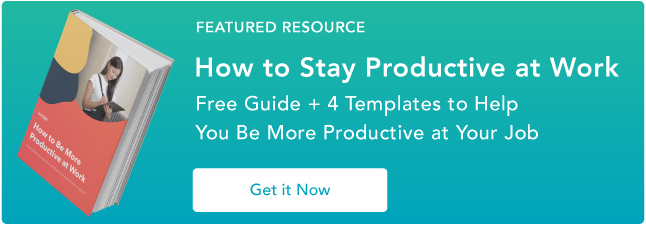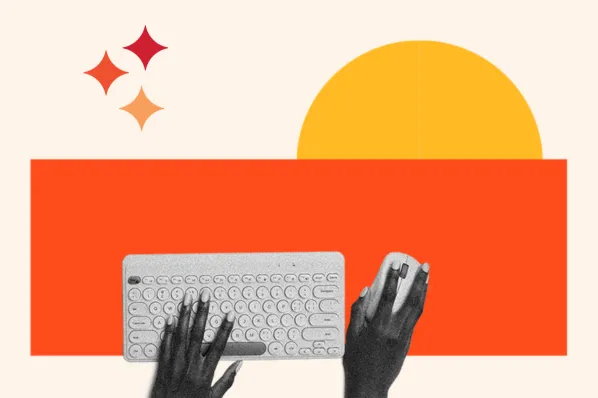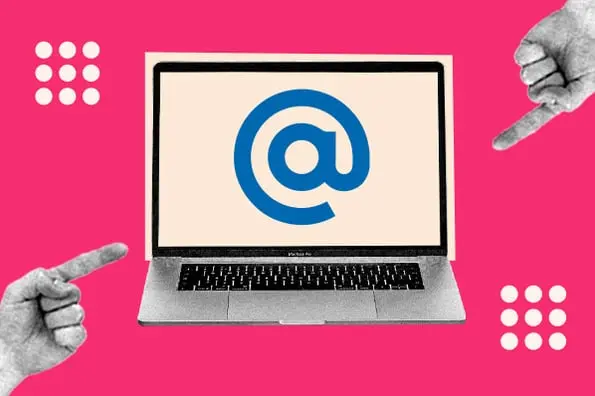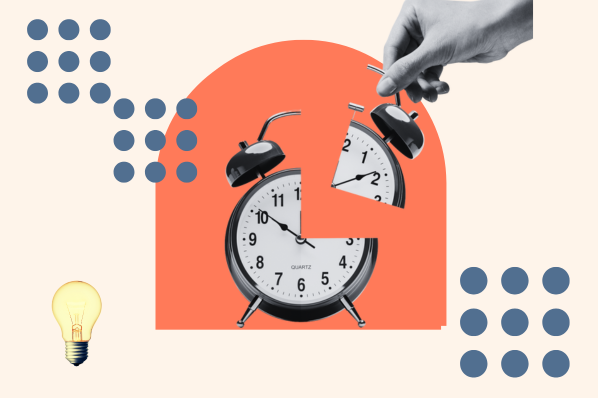It’s estimated that a shocking 60% (or less) of work time is spent productively, according to Atlassian. Time is our scarcest resource, yet we spend so much of it doing things that are unproductive — usually without meaning to.

Emails, meetings, endless notifications... We’re indeed being pulled in more directions than ever before, but it’s not just technology holding us back from making the most of our time. In many cases, we are the ones responsible for our own lack of productivity.
As a freelance remote worker, I’ve had to tango with my self-sabotaging productivity quirks more than most. I used to blame my workload and environment; it wasn’t until I was completely in control of those factors that I was left with the realization that I was the problem all along.
Like you, I’m more successful and happy when I’m productive. We’re all on the hunt for the magic bullet solution; this has led to the endless production of AI productivity tools and life-hack lists. How can we produce more while doing less?
We look over at the person who seems to get it all done while still managing to have a life, and we ask ourselves: What does she know that I don’t? Is there a secret to high productivity?
With some work, many of the barriers to productivity are solvable. However, to truly enhance productivity, you need to first understand it. Here’s what science says.
Table of Contents
- The Science of Productivity
- 9 Science-Proven Ways to Get More Done in a Day
- Data-Backed Productivity Tools

Free Workplace Productivity Guide
Stop procrastinating! Boost your productivity with this free kit.
- Free Productivity Guide
- PIE Scoring Template
- Labor Hours Calculator
- And more!
The Science of Productivity
“Productivity is the art and science of reshaping yourself and the world around you in a way that makes the world work better,” shares author and organization expert Frank Buck, Ed.D.
“While the literature on productivity is massive, it all points back to that one definition. Psychological research dating back to at least 1966 (J.B. Rotter) suggests that those who feel they can control their surroundings act upon those beliefs, persist longer, and achieve greater results,” Buck concludes.
Society has long been aware of a shared desire to improve productivity, yet the modern world has moved us further away from that dream.
Technology provides constant, endless distractions — and we feed into this by being subconsciously addicted to information.
Scientists have discovered that the dopamine neurons in our brains treat information as a reward.
While this makes sense evolutionarily — having access to relevant information like the location of food sources means we make better decisions and are more likely to survive — it also means we’re naturally attracted to distractions outside our primary objectives.
Insert: our phones. Smartphones are a distraction disaster. Here’s how to overcome the hurdles that technology presents.
9 Science-Proven Ways to Get More Done in a Day
A quick Google search will show you that most productivity lists recommend artificial intelligence software (AI). I’ll share some of the top AI productivity tools in a minute, but I encourage you to take AI tools with a warning.
An unproductive person throwing AI apps at their workload is like applying wax to a car before washing the dirt off. All of the AI capabilities in the world won’t boost productivity if you still undermine your own success. Start with these tips instead.
1. Use a to-do list.
Create a task list for yourself that includes ALL of your to-do’s, no matter how small. Each item on your list should be independently achievable. Break big tasks into small, individual steps.
The benefits are three-fold:
- Know what needs to be done. Task creation is a step in the decision-making process, and it’s more time-consuming than it looks on the surface.
- Remove the risk of forgetting. Relying on a mental to-do list creates unnecessary strain and stress, and trying to ad-lib your workload will result in missed tasks and poor time management.
- Create a workload that you can achieve. Writing unachievable task lists creates the feeling that you’re perpetually behind, and the inability to estimate your work output will eventually create a genuine problem. Technology writer Steven K. Roberts nicknamed this “The Roberts Law of Fractal To-Do List Complexity: Each item on a list is merely the title of another list.”
Why It Works
Imagine if you wanted to make a loaf of bread. You would never choose to guess and stumble your way through the process: “What comes next? Milk? I wonder how much I should use?”
No one would choose that path, yet many people approach their workload with this ad-lib mentality. A to-do list is like a recipe for your work, and it’s extremely effective when used properly.
Harvard Business Review says there are endless upsides to using to-do lists, with the only potential downside being that they don’t go far enough to push us to follow through.
“If every time we added an item to our to-do lists we also came up with a plan to specify what actions we need to take and when those actions need to be taken, that would help minimize the odds of our to-do lists becoming graveyards of unfinished items,” researcher E. J. Masicampo shared with Harvard Business Review.
Testing It Out
I’m no stranger to to-do lists. I fell in love when I was in college. I’m confident my to-do lists are the only reason I graduated, held down a job, wrote a book, or have ever done anything else productive in my life.
However, the Harvard Business Review interview made me realize that I wasn’t leveraging the full potential of to-do lists by not adding a timeframe to my intentions.
Normally, I create a to-do list for the week but don’t assign those tasks to a specific day. For the upcoming week, I tried assigning each task to a day of the week. I didn’t adhere to this perfectly, but this did eliminate the decision-making part of my morning, where I thought about what I felt like working on.
2. Just get started.
While it’s human nature to postpone tasks that feel intimidating, it’s incredibly counterproductive. Simply starting a task is a surefire way to kickstart your productivity.
For some, this might mean diving right in, even if you’re not sure where to begin. HubSpot UX Editor Beth Dunn told me that when she gets writer’s block, she just opens Google Docs and starts typing away, even if the words don’t mean anything.
For others, it might mean splitting big projects into smaller ones. HubSpot Co-Founder and CTO Dharmesh Shah said he likes to “deconstruct” the large problem at hand into smaller, bite-sized chunks.
Each of the individual, smaller things seem surmountable on their own, and it calms him to know that if he conquers all of those small things, he’s essentially conquered the big thing.
Why It Works
According to a study by award-winning psychology researcher, Dr. John Bargh, before we embark on big projects, our brains attempt to simulate real, productive work by focusing on small, mindless tasks to pass the time.
Consequently, this prevents us from getting real work done. Now it makes sense why my college dorm room was never cleaner than during finals week!
Once you get over that hump of starting, there’s good news: We feel naturally compelled to finish a task once we’ve already started, thanks to the Zeigarnik Effect.
According to Social Psychology and Human Nature, the Zeigarnik effect is “the tendency to experience intrusive thoughts about an objective that was once pursued and left incomplete.”
Testing It Out
I tested this theory out by making a strict plan for my Monday morning workload. In advance, I decided:
- What I would work on.
- Where I’d work from.
- Exactly what time I’d begin working.
- Which music I would listen to.
This amount of structure was foreign so I felt some natural resistance to it, but it did keep me from falling into the trap of busy work at moments in the day. When I woke up and thought about my day, I had immediate clarity.
3. Work with others.
Make yourself a part of a group, and you’ll be impacted by the focus and good habits of those around you. This can be done in person at the office or in a coworking space, or you can virtually co-work 24/7 through platforms like Study Together.

Free Workplace Productivity Guide
Stop procrastinating! Boost your productivity with this free kit.
- Free Productivity Guide
- PIE Scoring Template
- Labor Hours Calculator
- And more!
Why It Works
When you see others modeling good habits, there’s subconscious pressure to conform. You’re less likely to bust out your phone and browse social media posts when everyone in your direct vicinity is doing their work.
It’s a grown-up version of peer pressure, which Brett Laursen, Ph.D. said is really defined as influence. When interviewed on the American Psychological Association’s podcast Speaking of Psychology, Dr. Laursen said that “peer pressure follows people across their whole life course” and can be positive.
Testing It Out
As a remote freelance writer, I haven’t experienced coworkers in seven years. I’m accustomed to working alone, but I still eagerly tested out the virtual coworking space Study Together.
While this group was designed for students, I still carry a backpack and love a library work session as much as anyone, so I entered the virtual coworking session on a Saturday morning along with 213 others in my study room (pictured below: me about to enter my study room).
When I joined, there were an astounding 17,801 members active across all rooms. I was surprised to feel a sense of belonging as a result of the group size. We all worked silently alongside each other, and I really enjoyed the effect this had.
However, I think it’s much more powerful in person.
It’s important to note that coworking can also work against your productivity. The psychology of peer influence works both ways, so if you’re surrounded by unfocused individuals, you may feel yourself being negatively impacted.
4. Work in sprints.
We all know that an eight-hour workday isn’t meant to be swallowed in one bite; it needs to be broken up, but how? Improve productivity by breaking your day into predetermined work sessions with planned breaks.
Why It Works
Have you ever heard of the “basic rest-activity cycle” humans experience when we sleep? Physiologist Nathaniel Kleitman, the pioneering sleep researcher who co-discovered REM sleep, is also well known for observing that humans alternate progressively between light and deep sleep in 90-minute periods.
According to a Harvard Business Review article by Tony Schwartz, Kleitman found that we operate by that same 90-minute rhythm during the day by moving progressively through periods of higher and lower alertness.
After working at high intensity for more than 90 minutes, writes Schwartz, we begin relying on stress hormones for energy. The result: Our prefrontal cortex starts to shut down, and we start losing our ability to think clearly and reflectively.
“We move from parasympathetic to a sympathetic arousal — a physiological state more commonly known as ‘fight or flight,’” Schwartz says.
So instead of artificially overriding periods of low alertness with caffeine, sugary foods, and stress hormones, you can better manage your time at work by respecting the human need for rhythmic pulses of rest and renewal.
Testing It Out
I’m a seasoned sprint worker, so I didn’t need to test this technique. However, I was surprised to learn that this has yielded results across diverse fields.
A man named Anders Ericsson conducted a study of elite musicians and found they don’t necessarily practice more — they just practice more deliberately. “
They focus their energy in packets,” says Gregory Ciotti in an explanation of Ericsson’s study.
This means “periods of intense work followed by breaks, instead of diluting work time over the whole day. They don’t rely on willpower — they rely on habit and disciplined scheduling.”
Ericsson’s study of elite violinists found they tend to follow 90-minute periods of hard work with 15- to 20-minute breaks.
Rest periods get a bad rap in today’s working world, but it turns out they are integral to high productivity over long periods.
5. Don’t eliminate old habits; change them.
For some of us, it’s bad habits like checking email every few minutes or opening up social media that cost us (and others) precious productivity time.
Sometimes, these habits become so automatic that we don’t even realize we’re doing them. Identify the habit that disrupts your productivity the most and replace it with something else.
Why It Works
Pulitzer Prize-winning reporter Charles Duhigg spent years researching the power habits have over us. He found that rather than trying to eliminate an old habit, people find more success in changing that habit by replacing it with a new, less destructive one.
Why? Because every time you have an urge and you do something about it, the reward you get from it creates a neurological pathway in your brain.
When you repeat that action and experience the same reward again, that neurological pathway gets a little bit thicker; and the next time, even thicker. The thicker that pathway gets, the easier it is for impulses to travel down it.
So when you try to extinguish a habit completely, you’re actually trying to use willpower to destroy a neural pathway. It’s possible, but it’s ineffective.
So if you’re having trouble eliminating a habit that’s keeping you from being productive, here’s what Duhigg suggests you do:
- Diagnose the “cue” or the urge that sets off the habit.
- Diagnose the reward you get from doing that habit.
- Replace your habit with an activity that’s both triggered by the old cue and delivers the old reward or a version of it.
Testing It Out
When my brain buffers and I want a quick dopamine hit, I reach for my phone without thinking. Instead of trying to quit this behavior, I replaced checking my phone with checking my laptop background.
Using Canva, I created a collage of images that cause feelings of gratitude, happiness, and anticipation. Instead of reaching for my phone, I now press “windows+M” (to minimize all tabs) and get a dopamine hit that makes me feel grateful, centered, and excited about the plans I have ahead.
Not only do I waste less time on my phone, but I’ve also replaced my normal social media scroll with something that leaves me feeling better.
6. Create productive rituals.
Speaking of building better habits, Schwartz says the best way to get things done “is to make them more automatic so they require less energy.”
As President and CEO of The Energy Project, he advises his clients to develop rituals: highly specific behaviors done at precise times that, over time, become so automatic that they require no conscious will or discipline.
For example, Schwartz makes a habit of immediately writing down new tasks he needs to accomplish and new ideas that occur to him. That way, he never has to walk around preoccupied with the burden of remembering something.
David Allen, productivity consultant and author of the best-selling book Getting Things Done, would agree: “People don’t capture stuff that has their attention. And it keeps rolling around in the organizational psyche as well as the personal psyche, draining energy and creating incredible psychic residue.”
According to Allen, when people say they’ll do something but don’t write it down, it goes into a black hole.
“That would be fine if it were just one thing, but it’s hundreds of things ... Your head is for having ideas, not holding them,” Allen says. “Just dumping everything out of your head and externalizing it is a huge step, and it can have a significant effect.”

Free Workplace Productivity Guide
Stop procrastinating! Boost your productivity with this free kit.
- Free Productivity Guide
- PIE Scoring Template
- Labor Hours Calculator
- And more!
Why It Works
We mentally pick up pieces of information all day and let them slosh around our subconscious minds. Emails, tasks that you realize need to be completed — they accumulate like picking up groceries at the store until your arms are overflowing and you start to drop things.
Without rituals that dictate when you answer that email, which order to tackle your to-do list, and every other micro-decision in your day, you’re repeatedly half-handling tasks all day long.
Another version of Schwartz’s philosophy is what Harvard Business Review’s Gretchen Gavett calls OHIO: Only Handle It Once.
For example, when you go through your email, decide immediately what to do with each one — immediately respond to the ones that need answering, and delete the unimportant ones on the spot. Never read an email and think, “I’ll circle back to this later.”
Rituals are theorized to be the secret to productivity and happiness itself. “In an age of choice, rituals are the key to happiness,” The Guardian’s Tomiwa Owolade writes.
Testing It Out
For a week, I applied the OHIO technique to my inbox management system. I was guilty of checking emails around the clock just to feel updated, but I never replied to them right away. Without realizing it, I was handling every email multiple times.
This goes directly against the OHIO principle, so for a week, I only checked my email at the beginning and end of my workday, and I handled every email immediately.
My inbox anxiety essentially disappeared, and I replied to everything in a more timely manner. After a week of testing this, I removed my email accounts (both work and personal) from my phone altogether to make this a part of my routine.
7. Leverage peak productivity hours.
Everyone’s willpower is limited and generally stronger at the beginning of the day when they haven’t expended any energy yet.
You can leverage these peak productivity hours by scheduling your most important or most difficult tasks for the beginning of the day when you have the greatest willpower to avoid distractions.
Why It Works
Studies have concluded that willpower is a finite resource. Acts of self-control, like trying to remember to respond to an email or ignoring distractions, leave us with decreasing willpower throughout the day.
According to Lia Steakley of Stanford Medicine’s Scopeblog, “as with physical exercise, using your self-control muscles may be tiring, but over time the workout increases your strength and stamina. So, what starts out difficult becomes easier over time. New behaviors become habits, temptations become less overwhelming, and willpower challenges can even become fun.”
As you build habits like responding to emails right away and writing down all your to-do’s, you’ll eliminate the fear of forgetting — and therefore, the burden of remembering.
The result: more energy, more willpower, and better productivity.
Testing It Out
At the end of my workday, I reviewed my to-do list for the following day. I identified tomorrow’s most important task and decided to complete it first.
I usually like to work through my to-do list based on my mood, so it was hard to force myself to work on a specific task. In complete honesty, I didn’t succeed on my first attempt, but I tried again.
Even though I didn’t achieve 100% success, prioritizing my workload still made me feel less stressed and more in control of my day.
8. Time-blocking technique.
Time blocking is the process of determining exactly when you’ll work on a specific task and scheduling those tasks as if you’re scheduling a meeting.
These tasks are added to your Google Calendar, and you will show up at the predetermined time and do the planned work.
Why It Works
Most of us wouldn’t skip a meeting just because we didn’t feel like going, but we treat our own work tasks like this all the time.
When we say to ourselves, “I’ll work on X first thing tomorrow,” and then we fail to follow through, our confidence and ability to execute our intentions dwindles. Time blocking builds the muscle that restores this ability to follow through.
Cal Newport, author of the acclaimed book Deep Work, advocates for detailed time blocking of your entire work day. “A 40-hour time-blocked work week, I estimate, produces the same amount of output as a 60+ hour work week pursued without structure,” says Cal Newport.
Time blocking is perhaps the most impactful way to improve time management. Follow-through is improved, as is the quality of your focused work.
Testing It Out
A task I’ve been procrastinating on is updating my financial Google Sheets (fun, I know.) For weeks, I’ve been thinking, “Just do it. You’ll thank yourself when tax time comes around.” However, I still haven’t made any concrete progress on this task.
I time blocked three hours on my Google Calendar for next week to handle this. Even though I haven’t completed the task yet, having put it on my calendar makes me feel less anxious because I know it will be handled by the end of the allotted time.
9. Task batching.
Identify repetitive tasks in your workload and condense these to-do’s into a single task.
Here’s a task batching example: If you want to publish a post on LinkedIn every day, you can wake up every morning, come up with a posting idea, write it, and hit “publish.”
Or, you can batch this task once a week: For two hours every Monday morning, you can come up with seven post ideas, write them all, and schedule them to publish for the rest of the week.
Not only do you sidestep writer’s block every day, but the repetition naturally speeds up the rate at which you create this content.
Why It Works
Task batching will help you complete your tasks in a more efficient way while reducing multitasking.
The human brain isn’t wired to multitask; it can reduce your productivity by up to 40%. The inverse of multitasking is monotasking: focusing on a single task, removing distractions, and completing the task at hand.
As a side effect, this task management technique also helps you improve the efficiency of your work. Inefficiencies in your workflow aren’t always easy to spot when you work on a task periodically.
When you force yourself to repeat a process several times in a row, you naturally find time-consuming steps that can be condensed or handled by AI productivity apps.
Testing It Out
Like most entrepreneurs, content creation is a part of marketing my business.
It’s something I tend to postpone because it’s not a part of my client deliverables. Pinterest is one of my business’s most important channels, and I used to schedule pins week by week.
Using the task batching technique, I planned two months of content creation at once. I created all of the pin images, wrote the descriptions, and scheduled them.
It was a lengthy process, but it was a relief to know that this to-do was off my plate for the foreseeable future.
While batching this task, I discovered just how much time I was wasting when completing it week by week. I’ve adjusted my process permanently.

Free Workplace Productivity Guide
Stop procrastinating! Boost your productivity with this free kit.
- Free Productivity Guide
- PIE Scoring Template
- Labor Hours Calculator
- And more!
Data-Backed Productivity Tools
With the psychology understood and our personal habits examined, it’s time to look at the tools and AI apps that can help take our productivity even further.
Pomodoro Timer
Remember physiologist Nathaniel Kleitman, who said that we work better in cycles? Make cycles a part of your routine with a Pomodoro timer.
The Pomodoro Technique is a method developed by Francesco Cirillo, which breaks blocks of time down into chunks of work and breaks.
You can use any time configuration, but a popular one is 25 minutes of work with a 5-minute break, then taking a 15-minute break every four work cycles.
Don’t use your phone timer as a timer; instead, install a browser extension like the Pomodoro® Assistant Google Chrome extension. It’s free and displays how much time is left in your time block on your screen, removing the temptation to check your phone.
Here’s what pops up on your computer when you’ve earned a break. Each red dot represents a completed work session:
What I like: I never feel guilty or wonder if I’ve “earned” a break when using my Pomorodo timer; I rely on data instead of emotions, and it takes all of the guesswork out of structuring my day.
AI Productivity Tools
In 2009, Apple invented the catchy phrase “there’s an app for that.” Now, there’s an AI tool for that, too. Here are some popular tasks and the AI productivity tools that assist with them:
- Try AI transcription apps like Fathom.
- Automate repetitive tasks with tools like Bardeen.
- Analyze data with tools like Tableau.
- Handle project management with tools like ClickUp.
- Draft emails with tools like HubSpot AI.
Best for: Speeding up refined processes, doing mundane tasks, or automating repetitive tasks.
Task Management Software
Task tracking is an important tool in your productivity arsenal, and there’s a task management app for every style and preference.
Here are some of my favorite task management apps, which all have free versions with premium upgrades available (except for HubSpot Tasks, which is free):
These project management tools also incorporate AI. We compare them in our AI project management tools analysis.
Task management is never more important than when you’re working on collaborative projects. All of these apps work for individuals as well as teams.
What I like: I love seeing project updates at a glance and the flexibility to capture all ideas via endless media, attachments, and notes.
News Feed Eradicator
Anyone who works in social media management or content creation knows what a double-edged sword social media is for productivity.
If being on social media is a part of your job, you can make it less of a productivity black hole with the free News Feed Eradicator Google Chrome extension.
This tool blocks out the news feed of social media websites, while still allowing you to answer messages, converse in groups, reply to comments, etc.
Best for: People who need social media as a part of their day-to-day work but want to limit how time-consuming it is.
BlockSite
Is there a specific website that sabotages your productivity?
Make it inaccessible using the app BlockSite. BlockSite is a free tool that’s available on Google Chrome, Firefox, Safari, the App Store, and more.
The free version allows you to block three websites, and you can upgrade to add more.
What I like: This fosters a level of self-awareness and reflection that’s healthy and productive.
Do your distractions require a firmer hand? The “GO ‘FREAKING’ WORK” (expletive removed) Google Chrome extension does the same thing but offers a verbal insult every time you open up a blocked website.
Getting Started
Which of these techniques will change your life?
I can say with utter confidence that OHIO (only handle it once) has already changed my life; I’ve found myself fitting it into conversation and recommending it to everyone. There was a similar “love at first sight” effect when I discovered to-do lists and the Pomodoro technique years ago.
Whether you’re pursuing academic success, need help focusing on specific tasks, or just want to get your valuable time back, these tips will help you regain some control over how you spend your time.
Who knows what potential is hiding underneath all of your unproductive habits.
That extra time may just move mountains, alter your career, or completely change your life. Better start today!





![How to Delete Your Instagram [Easy Guide]](https://blog.hubspot.com/hubfs/delete-instagram.png)


![How to Edit a PDF [Easy Guide]](https://blog.hubspot.com/hubfs/280_How-to-Edit-PDF.png)
![Businesses Still Can't Nail Effective Communication [New Data]](https://blog.hubspot.com/hubfs/business%20communication.jpg)
